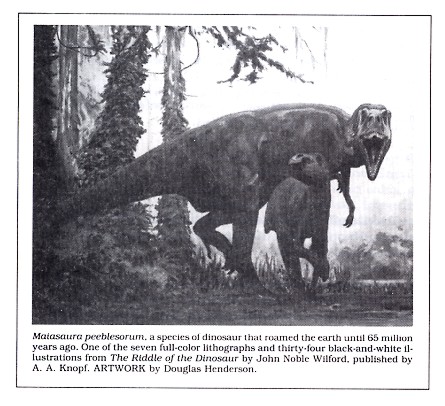These may be the best three recent books about dinosaurs written for the general reader. Sattler's Dinosaurs of North America won the Golden Kite Award from the Society of Children's Book Writers and is the least technical, designed for younger readers and school libraries. It consists of an alphabetical listing of known dinosaurs from the Triassic, Jurassic, and Cretaceous plus a chapter on extinction theories. Glut's work, The New Dinosaur Dictionary, is worldwide in scope and thus includes vastly more genus names and illustrations. There is also an introductory explanation or definition of dinosaurian orders, families, and subfamilies. It is invaluable as a reference to dinosaur nomenclature, alternative names, discoverer, date of discovery or naming, and morphology. Drawings and photographs illustrate specific animal reconstructions, bones, teeth, and footprints. There is even an appendix listing now-discarded names. As a taxonomic guide, the book is unequaled. No library or dinosaur fanatic should be without it, but it is strictly a reference book on namesnot theory or interpretation. It does not dwell on phyletic relationships except in a Linnaean taxonomic sense, let alone upon evolutionary theory.

Wilford's The Riddle of the Dinosaur is entirely different. Its very readable, narrative style brings together virtually everything the nonspecialist wants to know about dinosaursincluding the surprising fact that there are rather few dinosaur specialists. The fossils which probably inspired every child who later became a paleontologist to choose that career were, for a long time, the preserve of explorers and collectors rather than evolutionary biologists or anatomists. Wilford traces the early days of dinosaur-hunting, especially the fierce, nearly murderous nineteenth-century competition between Othniel Charles Marsh of Yale and Edward Drinker Cope, a wealthy Philadelphia amateur scientist. Wilford records both earlier and later quests and discoveries, culminating in Roy Chapman Andrews' 1922 Central Asiatic expedition which led forty scientists and explorers to the Gobi Desert at the apogee of romantic, pith-helmeted Western explorations of remote Eastern and African lands. Movie archaeologists and paleontologists even today follow the stereotype; Andrews would have approved of Indiana Jones. Andrews was searching for the origins of humans, hoping to show that Darwin was wrong about Africa being the likely human hearth, but he had to settle for some of the most extensive fossil nonhumans ever found.
Wilford notes the beginnings of more modern interests by other explorers, such as Barnum Brown of the American Museum of Natural History and Brown's assistant, Roland T. Bird, who discovered the Glen Rose, Texas, trackways in the late 1930s (not the 1940s, as the author writes). These tracks became creationists' happy human footprint hunting ground in later years. (Wilford notes this, and its baselessness, in a footnote about the "Palaxy" [sic] tracks, quoting Steven Schafersman's 1983 letter to Geotimes. Such footnotes appear repeatedly, apparently last-minute additions to a manuscript largely finished between 1983 and 1984, despite the 1986 copyright.) By World War II, dinosaur behavior, not just bones, was being seriously studied. Bird showed that Brontosaurus (now called Apatosaurus) walked on land rather than floated in shallow water and that adults left tracks on either side of an infant, seemingly to protect it from the approach of a carnivore whose tracks run into the quadrupeds' trail. (Actually, Bird was dealing with a much more recent creature, probably Pleuroceolus, not Apatosaurus; this series of minor errors within a few pages on a topic I know well is disturbing, but the general discussion of issues is not affected.)
The balance of the book discusses the controversies and theories generated in recent years as dinosaur-collecting has yielded to studies of locomotion, anatomy, social life, diet, adaptation, evolution, and extinction. Bakker's warm-blooded dinosaur hypothesis and its critics, the relationship between birds and dinosaurs, and "the great dying" are among the topics. Gradual extinction theories, the Alvarezes' asteroid impact theory, Sepkoski and Raup's alleged 26-million-year cycle of such impacts blamed by R. Muller, Hut, and others upon a postulated "death star" solar companion are discussed in detail, although recent challenges to Raup's calculations did not meet the book's deadline. Also discussed are the implications for mammal and human evolution and the potentials for extinction via global "winter" caused by nuclear war or asteroid.
Wilford, a Pulizter Prize-winning science writer for the New York Times, has produced an outstanding survey of what we do and do not know about dinosaursand how we are learning more. Some petty errors bother me, but the author succeeds very well in relaying the issues and information across the invisible boundary usually separating scientists and their public constituents. He shows the drama and humanness of science, from the excitement of discovery and ideas to the pettiness and errors and arguments and personal accomplishments.
